How Does Outdoor Spatial Design Shape the Microclimate, Comfort, and Behavior in Traditional Chinese Villages? A Systematic Review Across Scales, Contexts, and Users
Abstract
1. Introduction
- What are the current research trends and distributions concerning the microclimate spatial mechanisms?
- What conceptual framework could effectively represent the microclimate spatial mechanisms in traditional villages?
- What are the key indicators and appropriate methodologies commonly used to assess spatial microclimate?
- How do specific microclimate spatial mechanisms vary across scales, contextual conditions, and user groups?
2. Methods
2.1. Identification
2.2. Screening
2.3. Inclusion
| Author | Year | Research Objects (Village) | Methods | Research Contents |
|---|---|---|---|---|
| [31] | 2013 | Xitang, Zhejiang Province; Hongcun, Anhui Province | Field Measurement | The study verifies the cooling effect of ‘cold alleys’ in traditional settlements. |
| [32] | 2014 | Daqitou Village, Xiaozhou Village, Guang Dong Province | Simulation | The current thermal environment conditions of three villages (incl. a modern village) and their comparison, with a focus on the influence of spatial mechanisms on thermal environment and comfort. |
| [33] | 2016 | Pingshan, Xidi, Lucun, and Xixinan, Anhui Province | Field Measurement, Formula | This study evaluates and compares the overall and individual conditions of thermal comfort of three villages, analyzing the influence of outdoor spatial characteristics on microclimate and thermal comfort. |
| [34] | 2017 | Nanshe Village, Lingnan Region, Guangdong province | Field Measurement | This study analyzes the temperature variation patterns and differences of four different outdoor underlying surfaces of residential buildings and analyzes the spatial factors. |
| [35] | 2018 | Songkou Ancient Town, Yongtai County, Fujian Province | Field Measurement | This study analyzes how landscape elements in waterfront spaces, plaza spaces, and street–alley spaces of historic towns influence the spatiotemporal variations of the microclimate and proposes corresponding design strategies. |
| [25] | 2018 | Dayuwan Village, Huangpi District, Hubei Province | Field Measurement, Survey | The study investigates the relationship between environmental characteristics and the diurnal variation of the microclimate, evaluates user behavior and usage patterns, and proposes corresponding mitigation strategies. |
| [36] | 2018 | Zhonglou Village, Daqitou Village, and Shuikong Village, GuangDong Province | Field Measurement, Simulation | This study analyzes the climate adaptability of the overall spatial system and core spatial elements of the villages and explores the organizational patterns of space and scale. |
| [37] | 2018 | Lutaoyang, Taiwan Province | Field Measurement, Simulation | This study identifies areas of high outdoor thermal heat stress, evaluates current and predicts future changes in thermal conditions of the village located in a heat risk zone, and analyzes tourists’ thermal comfort under different shading conditions. |
| [38] | 2019 | Tongli Ancient Town, Jiangsu Province | Field Measurement | This study analyzes the relationship between spatial typologies in outdoor public spaces of traditional water towns and their effectiveness in shaping microclimate perception and proposes corresponding design strategies. |
| [39] | 2020 | Yangtou Village, Fujian Province | Field Measurement | This study analyzes the spatiotemporal characteristics of microclimate variations in traditional villages and summarizes the mechanisms through which different spatial layouts and landscape elements influence the winter microclimate of public spaces in these villages. |
| [40] | 2020 | Puyuan Village, Fujian Province | Field Measurement, Formula | This study conducts on-site microclimate measurements in the village, analyzing the patterns and characteristics of microclimate elements. Using human thermal comfort, it assesses comfort levels within different village spaces and explores the influence of spatial elements on the village microclimate. |
| [41] | 2020 | Songkou Ancient Town, Fujian Province | Field Measurement, Formula | This study explores the relationship among spatial characteristics, microclimate elements, and tourists’ thermal comfort in the village. |
| [42] | 2021 | Gaodang Village, Guizhou Province | Field Measurement, Simulation | This study evaluates the indoor and outdoor thermal environment of the village during summer and explores its relationship with spatial characteristics. |
| [43] | 2021 | Kanez Village, Xinjiang Province | Field Measurement, Simulation | This study evaluates the thermal environment issues in outdoor public spaces of arid and hot regions and proposes corresponding mitigation strategies. |
| [44] | 2021 | Fangyu Village, Shandong Province | Simulation | This study analyzes the wind and thermal environments of the village, focusing on the coupling relationship between spatial morphology and characteristics of wind speed and thermal radiation. |
| [45] | 2021 | Hengtang Village, Zhejiang Province | Field Measurement, Simulation | At both the village planning and individual dwelling levels, this study analyzes and summarizes the spatial characteristics and structural strategies adopted to adapt to the local climate. |
| [46] | 2021 | Mazha Village, Xinjiang | Simulation | An assessment of thermal comfort was conducted, alongside an investigation into how street layout and internal landscape elements influence the microclimate and the mechanisms underlying thermal comfort. |
| [47] | 2021 | Bayu Ancient Towns, Chongqing Municipality | Field Measurement, Simulation | Using historic and cultural towns in the Bayu region as case studies, this research investigates the relationships between landscape patterns, street networks, architectural layouts, and the mountainous terrain and wind environment, in order to reveal the mechanisms by which spatial forms at multiple scales adapt to the local climate. |
| [48] | 2021 | Zhongtian Village, Hunan Province | Field Measurement | This study investigates the relationship between village spatial morphology and the wind–thermal environment. |
| [26] | 2021 | Mi Zhi Cave Dwellings, Shanxi Province | Field Measurement, Simulation, Survey | This study evaluates the thermal comfort and heat adaptation behaviors of residents in cave-dwelling regions. |
| [49] | 2022 | Baoping Village, Hainan Province | Field Measurement, Observation | Through summer outdoor thermal environment measurements and behavioral observations in the village, this study explores the impact of temperature and wind speed on human thermal comfort and proposes several suggestions for optimizing the outdoor thermal environment in tropical regions. |
| [50] | 2022 | Zhoutie Town, Jiangsu Province | Field Measurement, Simulation | This study investigated the spatiotemporal distribution characteristics of air temperature reduction induced by water bodies in the village. Correlation analysis was conducted between morphological indicators of the village and the cooling intensity of water bodies across different buffer radii. Based on this, a regression model was constructed to predict water body cooling intensity using village morphological parameters. |
| [51] | 2022 | Xufan Village, Henan Province | Field Measurement, Simulation | This study evaluates the impact of water-adaptive spaces in traditional pond-based settlements on the local microclimate. It analyzes the morphological characteristics of the settlement and simulates the effects of water bodies and spatial form elements on human thermal comfort. |
| [52] | 2022 | Cai Jia and Da Nihe Village, Shaanxi Province | Field Measurement, Simulation | This study explores the mechanistic relationship between microclimate and spatial morphology of the village in northwest China. |
| [1] | 2022 | Shecun Village, Jiangsu Province | Field Measurement, Simulation | The current work discusses the relationship between the spatial form of landscape outside traditional villages, street space, and public space inside the villages and microclimate factors and tries to present useful tips for designers. |
| [53] | 2022 | Linpan Village, Sichuan Province | Field Measurement, Simulation | The study investigates the relationship between spatial characteristics, site selection, overall spatial forms such as street space and public space, and climatic factors, with the aim of providing practical insights for designers. |
| [4] | 2023 | Manjingbao, Manchunman, and Man Village, Yunnan Province | Field Measurement, Survey | This study investigates the microclimatic characteristics of traditional Dai ethnic villages and integrates thermal comfort indices, aiming to identify the microclimate comfort zone specific to traditional Dai settlements under the distinct climatic conditions of the region. |
| [54] | 2023 | Lefeng Village, Shaanxi Province | Simulation | This study evaluates and simulates the thermal comfort of outdoor public spaces in traditional villages, examining the relationships between multiscale spatial structures, organizational forms, and microclimate within the settlements (incl. spatial mechanisms). |
| [55] | 2023 | Huanglongxian Village, Jiangsu Province | Field Measurement, Simulation, and Survey | The study investigates the correlations between different types of outdoor spaces—such as courtyard spaces, street and alley spaces, waterfront areas, and recreational spaces—and microclimatic factors as well as human thermal comfort. |
| [56] | 2023 | Haifangwei Village, Shandong Province | Field Measurement, Simulation | In response to the seasonal and hierarchical ventilation demands of cold coastal regions, this study analyzes the influence patterns of three spatial morphological features—settlement orientation, street configuration, and courtyard layout—on natural ventilation, and proposes appropriate strategies for regulating and optimizing the spatial form of coastal military defense settlements in cold regions. |
| [57] | 2023 | Maan, Zhaoxing, and Gaoyou Village, Guizhou Province | Field Measurement, Simulation | This study focuses on two distinct types of traditional Dong ethnic villages to summarize their climatic adaptation patterns and experiential strategies. |
| [8] | 2023 | Guan Weizi Village, Henan Province | Field Measurement, Simulation | This study analyzes and evaluates the thermal comfort of green spaces in the village. |
| [58] | 2023 | Banling, Langtou, and Chaoxi Village, LingNan | Field Measurement, Simulation | This study examines the influence of topographical features and architectural forms on solar exposure and ventilation conditions in traditional settlements located in China’s southern subtropical climate. |
| [10] | 2023 | Shimengao Village, Anhui Province | Field Measurement, Simulation | This study measures and validates the spatial layout and three distinct outdoor spaces of the village and investigates the spatiotemporal distribution and influencing factors of thermal comfort. |
| [3] | 2023 | Mingyuewan Village, Jiangsu Province | Simulation | This study evaluates the spatial accessibility of the entire village and its key nodes and examines the correlation between spatial accessibility and wind conditions, thermal environment, and climatic comfort. |
| [59] | 2024 | Tongli Ancient Town, Jiangsu Province | Field Measurement, Simulation | To analyze the impact of water body morphology on microclimatic perception in public spaces of traditional waterside settlements, this study focuses on how variations in water surface area influence thermal comfort. |
| [60] | 2024 | Fengtai Village, Chongqing Municipality | Field Measurement, Simulation | This study investigates the impact of traditional settlement spatial configurations on the wind environment in regions characterized by hot, humid, and low-wind climatic conditions. |
| [61] | 2024 | Changfang Village, Anhui Province | Field Measurement, Simulation | This study investigates the overall microclimate conditions and the spatiotemporal variations in outdoor thermal comfort in the Chaohu Lake region, as well as the relationships between spatial characteristics, microclimate, and thermal comfort. |
| [62] | 2024 | Fangjialiang Village, Hebei Province | Field Measurement | This study investigates the mechanism of landform and building layout on the thermal environment of villages in cold mountainous areas. |
| [63] | 2024 | Dayu wan Village, Hubei Province | Field Measurement, Simulation | This study analyzes the effects of 15 different predefined landscape design strategies—such as tree planting, building greening, and albedo adjustment—on thermal comfort across the four seasons. |
| [64] | 2024 | Tukeng Village, Fujian Province | Field Measurement, Simulation | This study examines the role of the maze-like layout of traditional coastal villages in Fujian in improving the wind environment. The research reveals that the nonlinear street networks and clustered building forms create multiple buffer zones, which effectively reduce wind speed and enhance wind regulation, thermal comfort, and disaster resilience. |
| [65] | 2024 | Da Nihe Village, Shanxi Province | Field Measurement, Simulation | This study reveals the spatiotemporal thermal effects of LPS (water storage project) on rural settlements and evaluates the thermal impacts of both current and hypothetical underlying surface types on air temperature. |
3. Results
3.1. General Results
3.2. Definitions, Scopes, and Framework
3.3. Indicators and Methodology
3.3.1. Indicators
3.3.2. Methodologies
- (1)
- Field Measurements
- (2)
- Simulations and calculations
- (3)
- Survey and observation
3.4. Spatial Design Mechanisms
3.4.1. Site Selection and Natural Surroundings
3.4.2. Village Geometry and Nature Configuration
3.4.3. Building Units and Landscape Elements
4. Discussion
4.1. Implications
4.2. Limitations
4.3. Future Research
5. Conclusions
Supplementary Materials
Author Contributions
Funding
Data Availability Statement
Conflicts of Interest
References
- Xiong, Y.; Zhang, J.; Yan, Y.; Sun, S.; Xu, X.; Higueras, E. Effect of the Spatial Form of Jiangnan Traditional Villages on Microclimate and Human Comfort. Sustain. Cities Soc. 2022, 87, 104136. [Google Scholar] [CrossRef]
- Huang, Y.; Wang, H. The construction wisdom of traditional settlement space from the perspective of Luxiang Ancient Village. Build. Cult. 2020, 12, 254–256. [Google Scholar]
- Zang, H.Y.; Hsieh, C.-M.; Cang, Y.; Gu, M. Microclimate Adaptability Analysis of Waterfront Traditional Villages: A Case Study of Mingyuewan Village in Suzhou. J. Water Clim. Change 2023, 14, 3329–3344. [Google Scholar] [CrossRef]
- Li, J.; Qu, Z.; Yi, Y.; Zhou, J.; Liu, X. Study on microclimate and comfort level of traditional Dai villages in Xishuangbanna. Build. Sci. 2023, 39, 42–53. [Google Scholar]
- PreventionWeb China: Hot or Cold, Rural Residents More Vulnerable to Extreme Temperatures|PreventionWeb. Available online: https://www.preventionweb.net/news/china-hot-or-cold-rural-residents-more-vulnerable-extreme-temperatures (accessed on 17 November 2024).
- China Meteorological Administration. The Number of Cold Days Is Decreasing in China. Available online: https://www.cma.gov.cn/2011xwzx/2011xmtjj/201812/t20181227_510495.html (accessed on 17 November 2024).
- Reuters Chinese Farmers Struggle with Climate Change; Reuters: London, UK, 2009.
- Cheng, Y.; Bao, Y.; Liu, S.; Liu, X.; Li, B.; Zhang, Y.; Pei, Y.; Zeng, Z.; Wang, Z. Thermal Comfort Analysis and Optimization Strategies of Green Spaces in Chinese Traditional Settlements. Forests 2023, 14, 1501. [Google Scholar] [CrossRef]
- Central Committee and State Council “Rural Revitalization Strategic Plan (2018–2022); Council of State of the People’s Republic of China: Beijing, China, 2017.
- Xiao, T.; Sheng, L.; Zhang, S.; Zheng, L.; Shui, T. Thermal Comfort Improvement Strategies for Outdoor Spaces in Traditional Villages Based on ENVI-Met: Shimengao Village in Chizhou City. Sustainability 2023, 15, 11785. [Google Scholar] [CrossRef]
- Zhuang, X.; Duan, Y.; Jin, H. Research progress on urban landscape microclimate. Chin. Landsc. Archit. 2017, 33, 23–28. [Google Scholar]
- Blanken, P.D.; Barry, R.G. (Eds.) Introduction. In Microclimate and Local Climate; Cambridge University Press: Cambridge, UK, 2016; pp. 1–8. ISBN 978-1-316-53598-1. [Google Scholar][Green Version]
- Wu, J.; Liang, C. Researches and Progresses on Microclimate from the Perspective of Landscape Architecture in China. South Archit. 2019, 116–123. [Google Scholar] [CrossRef]
- Wu, W.; Sun, N.; Guo, S. Research progress and prospects of China’s urban outdoor microclimate. Garden 2023, 40, 92–98. [Google Scholar]
- Zheng, W. Research progress on climate adaptability of rural settlements. J. Hum. Settl. West. China 2023, 40, 141–148. [Google Scholar]
- Feng, X.; He, C.; Fang, Z.; Ji, Z. Current status of research on outdoor thermal comfort. Build. Sci. 2017, 33, 152–158. [Google Scholar]
- ASHRAE Standard 55; 2013 ANSI/ASHRAE Standard 55-2013. American National Standards Institute: Washington, DC, USA, 2013.
- Brown, R.D. Microclimate Landscape Design, 1st ed.; John Wiley & Sons: New York, NY, USA, 1995; ISBN 978-0-471-05667-6. [Google Scholar]
- Liu, B.; Peng, X. Research progress and enlightenment on urban street microclimate comfort. Chin. Landsc. Archit. 2019, 35, 57–62. [Google Scholar] [CrossRef]
- Li, J.; Liu, N. The Perception, Optimization Strategies and Prospects of Outdoor Thermal Comfort in China: A Review. Build. Environ. 2020, 170, 106614. [Google Scholar] [CrossRef]
- Maroofee, P.; Hassan, N.; Ghaffarianhoseini, A.; Shin To, A. An Overview of Urban Village Open Spaces and Outdoor Thermal Comfort in Malaysia. J. Southeast. Asian Stud. 2018, 23, 128–151. [Google Scholar] [CrossRef]
- Lai, D.; Liu, W.; Gan, T.; Liu, K.; Chen, Q. A Review of Mitigating Strategies to Improve the Thermal Environment and Thermal Comfort in Urban Outdoor Spaces. Sci. Total Environ. 2019, 661, 337–353. [Google Scholar] [CrossRef] [PubMed]
- Li, D.; Liu, D.; Wang, X. A review of hard landscape design methods for alleviating urban heat island effect. Landsc. Archit. 2022, 29, 71–78. [Google Scholar]
- Yuan, T.; Hong, B.; Qu, H.; Liu, A.; Zheng, Y. Outdoor Thermal Comfort in Urban and Rural Open Spaces: A Comparative Study in China’s Cold Region. Urban Clim. 2023, 49, 101501. [Google Scholar] [CrossRef]
- Jin, Y.; Zhang, D.; Jia, X.; Wang, Z.; Chen, J. Study on Climate Comfort of Public Space in Traditional Villages in Hot Summer and Cold Winter Areas: A Case Study of Dayuwan Village in Wuhan. Urban Archit. 2018, 23, 72–75. [Google Scholar] [CrossRef]
- Ma, X.; Zhang, L.; Zhao, J.; Wang, M.; Cheng, Z. The Outdoor Pedestrian Thermal Comfort and Behavior in a Traditional Residential Settlement—A Case Study of the Cave Dwellings in Cold Winter of China. Sol. Energy 2021, 220, 130–143. [Google Scholar] [CrossRef]
- PRISMA PRISMA 2020 Flow Diagram. Available online: https://www.prisma-statement.org/prisma-2020-flow-diagram (accessed on 13 October 2024).
- Liberati, A.; Altman, D.G.; Tetzlaff, J.; Mulrow, C.; Gøtzsche, P.C.; Ioannidis, J.P.A.; Clarke, M.; Devereaux, P.J.; Kleijnen, J.; Moher, D. The PRISMA Statement for Reporting Systematic Reviews and Meta-Analyses of Studies That Evaluate Health Care Interventions: Explanation and Elaboration. Ann. Intern. Med. 2009, 151, W-65. [Google Scholar] [CrossRef]
- Editage Insights. Should Previous Systematic Reviews and Meta-Analyses Be Included in a Systematic Review? Available online: https://www.editage.com/insights/should-previous-systematic-reviews-and-meta-analyses-be-included-in-a-systematic-review (accessed on 18 November 2024).
- GB 50176–51993; China Academy of Building Science Thermal Design Code for Civil Buildings. Ministry of Housingand Urban-rural Development of the People’s Republic of China: Beijing, China, 1993. Available online: https://www.doc88.com/p-0117873451551.html (accessed on 18 November 2024).
- Chen, X.; Fu, X.; Zheng, B. Actual Measurement Analysis of Lowering Temperature in Cooling Alley of Folk House. J. Archit. 2013, 82–85. [Google Scholar]
- Li, K.; Zhao, L. Study on Thermal Environment Simulation of Villages in the Pearl River Delta Region. NanFang Archit. 2014, 2, 61–65. [Google Scholar]
- Xue, J.; Huang, X.; Wang, K.; Tang, J.; Jiang, S. Field measurement and analysis of outdoor thermal environment in traditional Huizhou settlements in summer. Meteorol. Environ. Sci. 2016, 39, 38–42. [Google Scholar] [CrossRef]
- Li, J.; Zhou, X. Comparative observation and analysis of temperature distribution on different underlying surfaces. Build. Sci. 2017, 33, 32–36, 52. [Google Scholar]
- Wang, D.; Cheng, H.; You, D.; Fan, X.; Lan, S.; Li, X. An empirical study on the creation of microclimate in traditional villages: A case study of Songkou Town, Yongtai County, Fujian Province. J. Henan Inst. Sci. Technol. Nat. Sci. Ed. 2018, 46, 14–20. [Google Scholar]
- Xiao, Y.; Lin, H.; Hui, X. A Study on Climate Adaptive Space System of the Traditional Villages in the Guangfu Region. NanFang Archit. 2018, 62–69. Available online: https://d.wanfangdata.com.cn/periodical/ChVQZXJpb2RpY2FsQ0hJMjAyNTA2MjISDW5manoyMDE4MDUwMTAaCGRvcDZ3b2Vi (accessed on 18 November 2024).
- Huang, K.-T.; Yang, S.-R.; Matzarakis, A.; Lin, T.-P. Identifying Outdoor Thermal Risk Areas and Evaluation of Future Thermal Comfort Concerning Shading Orientation in a Traditional Settlement. Sci. Total Environ. 2018, 626, 567–580. [Google Scholar] [CrossRef] [PubMed]
- Ma, C.D.; Liu, B.; Zhang, L. Evaluation of Microclimate Experience in Public Space of Watery Villages——Taking Tongli Ancient Town as an example. Resid. Technol. 2019, 39, 58–63. [Google Scholar] [CrossRef]
- Chen, X.; Liu, H.; Wang, Y.; Xie, X. Field study on winter microclimate of public space in traditional villages in mountainous areas of eastern Fujian: A case study of Yangtou Village. Sichuan Archit. 2020, 40, 34–37. [Google Scholar]
- Chen, X.; Xie, X. Field measurement and comfort analysis of winter microclimate in public residential spaces in Puyuan Village. J. Ningde Norm. Univ. Nat. Sci. Ed. 2020, 32, 421–428. [Google Scholar] [CrossRef]
- Cheng, H.; You, D.; Liu, Q.; Li, X.; Lan, S. Study on the relationship between microclimate and spatial characteristics of tourist routes in Songkou Ancient Town. Chin. Landsc. Archit. 2020, 36, 83–88. [Google Scholar] [CrossRef]
- Hu, L.; Xiong, K.; Yang, Z. Indoor and Outdoor Thermal Environment of Mountain Settlement Based on Ladybug. Huazhong Archit. 2022, 40, 65–70. [Google Scholar] [CrossRef]
- Tuoheti, A.; Zhu, L.; Wang, W. Simulation Study on Thermal Comfort of Public Space in Karez, Turpan. Xian Jianzhu Keji Daxue XuebaoJournal Xian Univ. Archit. Technol. 2021, 53, 617–624. [Google Scholar] [CrossRef]
- Fan, Y.; Liu, S.; Zhang, Y.; Li, Y. Parametric Analysis of Spatial Construction Characteristics of Traditional Villages in the Middle Hilly Area of Shandong Province——Taking Fangyu Village of Jinan City as An Example. Shandong For. Sci. Technol. 2021, 51, 20–28. [Google Scholar]
- Guo, W.H.; XinYu, W.; Zhang, G.; Li, W. Study on climate adaptability of traditional villages and dwellings: A case study of Hengtang Village in Dongyang. West. J. Hum. Settl. 2021, 36, 134–140. [Google Scholar]
- Ye, J. Evaluation of climate adaptability of traditional settlements in arid areas based on ENVI-met: A case study of Maza Village in Turpan. Huazhong Archit. 2021, 39, 53–57. [Google Scholar] [CrossRef]
- Li, X.; Ma, Y.; Cui, H.; Zhang, X. Study on the climate adaptability of the spatial form of traditional Bayu settlements. Urban Dev. Res. 2021, 28, 12–17. [Google Scholar]
- Lv, J.; Qi, Z.; Zhou, M.; Sun, S. Study on the relationship between spatial morphology of traditional villages in southern Hunan and summer monsoon heat environment. Chin. Overseas Archit. 2021, 116–120. [Google Scholar] [CrossRef]
- Chen, W.; Wu, Y.; Wang, S. Evaluation and Analysis of the Outdoor Microclimate Environment in Traditional Settlements in Tropical Areas in Summer: A case study of Baoping Village. Mod. Gard. 2022, 45, 29–31. [Google Scholar]
- Wu, Y.; Peng, C. Analysis of the influence of village and town morphological elements on the cooling effect of water microclimate. J. Southeast Univ. Nat. Sci. Ed. 2022, 52, 179–188. [Google Scholar]
- Cheng, Y.; Liu, X.; Zeng, Z.; Liu, S.; Wang, Z.; Tang, X.; He, B.-J. Impacts of Water Bodies on Microclimates and Outdoor Thermal Comfort: Implications for Sustainable Rural Revitalization. Front. Environ. Sci. 2022, 10, 940482. [Google Scholar] [CrossRef]
- Xin, K.; Zhao, J.; Wang, T.; Gao, W. Supporting Design to Develop Rural Revitalization through Investigating Village Microclimate Environments: A Case Study of Typical Villages in Northwest China. Int. J. Environ. Res. Public Health 2022, 19, 8310. [Google Scholar] [CrossRef]
- Zhang, L.; Liu, H.; Wei, D.; Liu, F.; Li, Y.; Li, H.; Dong, Z.; Cheng, J.; Tian, L.; Zhang, G.; et al. Impacts of Spatial Components on Outdoor Thermal Comfort in Traditional Linpan Settlements. Int. J. Environ. Res. Public Health 2022, 19, 6421. [Google Scholar] [CrossRef]
- Li, J.; Ying, Y.; Feng, Y. Application of simulation and Spatial Optimization of Microclimate Environment in Traditional Villages: A case study of Lefeng Village in Hanzhong City. J. Xian Polytech. Univ. 2023, 37, 34–41. [Google Scholar]
- Xiong, Y.; He, Y.; Yang, Y. Analysis of Spatial Pattern of Traditional Villages from the Perspective of Climate Adaptability: A Case Study of Huanglongxian Village in Jiangning District, Nanjing. J. Northwest For. Univ. 2023, 38, 217–227. [Google Scholar]
- Xu, S.; Li, H.; Xiao, W. Analysis on the Influence of Settlement Space form on Natural Ventilation in Cold Coastal DefenseAreas. Inter. Des. Decor. 2023, 9, 116–118. [Google Scholar]
- Zhang, Q.; Lai, Y.; Huang, Q.; Zhang, A. Study on Climate Adaptability of Traditional Dong settlements. West. J. Hum. Settl. 2023, 38, 141–146. [Google Scholar] [CrossRef]
- Lei, Y.; Zhou, H.; Li, Q.; Liu, Y.; Li, J.; Wang, C. Investigation and Evaluation of Insolation and Ventilation Conditions of Streetscapes of Traditional Settlements in Subtropical China. Buildings 2023, 13, 1611. [Google Scholar] [CrossRef]
- Ma, C.; Wang, Y.; Zhang, L. Impact of the Water Area Changes in Jiangnan Watery Settlement on the Thermal Comfort of Public Space—A Case Study of Tongli Ancient Town. Tradit. Chin. Archit. Gard. 2024, 68–74. Available online: http://gjyl.ijournals.cn/gjyl/article/abstract/202417013 (accessed on 18 November 2024).
- Xu, H.; Xia, H.; Dong, L.; Liu, T. Effect of Traditional Settlement Space on Wind Environment in Hot and Humid Windy Areas. J. Shenyang Jianzhu Univ. Nat. Sci. Ed. 2024, 40, 495–504. [Google Scholar]
- Yao, Y.; Tao, Y.; Guan, Z.; Han, X.; Ai, X.; Chang, X. Research on Thermal Comfort of Public Space in Traditional Villages Based on Numerical Simulation. J. Chang. Norm. Univ. 2024, 43, 111–119. [Google Scholar]
- Bian, G.-M.; Cheng, Q.; Yan, G.-N.; Sha, S.-Y.; Zhen, M. Effects of Landform and Building Layout on Outdoor Thermal Environment: A Case Study of Mountain Villages in Severely Cold Regions. J. Asian Archit. Build. Eng. 2024, 1–31. [Google Scholar] [CrossRef]
- Qin, Z.; Zhou, B. The Effects of Different Landscape Strategies on Outdoor Thermal Comfort in Village Squares: A Case Study in Dayuwan Village in Wuhan City. Environ. Sci. Pollut. Res. 2024, 31, 28594–28619. [Google Scholar] [CrossRef] [PubMed]
- Shen, X.; Wang, Y.; Xu, J.; Huang, T. A Study on Whether a ‘Maze’-like Layout Contributes to the Improvement of Wind Environments in Traditional Coastal Villages—A Validation Study Based on Numerical Simulation. Buildings 2024, 14, 2805. [Google Scholar] [CrossRef]
- Zhao, J.; Xin, K.; Wang, T.; Gao, W.; Guo, Y.; Zhang, T.; Zhang, J. Supporting Sustainable Rural Development through Numerical Simulation: A Case Study in Northwest China. Environ. Dev. Sustain. 2024, 27, 10995–11022. [Google Scholar] [CrossRef]
- Qi, T.; Li, J. Looking at the Hometown from a Distance: The Spatial and Temporal Distribution of Traditional Chinese Villages and Their Culture. Digit. Humanit. Res. 2024, 4, 64–89. [Google Scholar]
- Pan, Z.; Chen, Y.; Huang, Y.; Zheng, L. The Vernacular Cultural Landscape in Traditional Villages: Global Hotspots, Emerging Trends, and a Case Study of China’s Qilu Cultural District. Front. Earth Sci. 2024, 12, 1511292. [Google Scholar] [CrossRef]
- Ministry of Housing and Urban-Rural Development. Announcement of the Sixth Batch of Villages Included in the List of Traditional Chinese Villages; Ministry of Housing and Urban-Rural Development: Beijing, China, 2023.
- Chinese National Architecture Research Association. The Geographical Context and Architectural Cultural Characteristics of Traditional Chinese Villages; Chinese National Architecture Research Association: Beijing, China, 2024. [Google Scholar]
- Li, J.; Wang, X.; Li, X. Spatial Distribution Characteristics and Influencing Factors of Chinese Traditional Villages. Econ. Geogr. 2020, 40, 143–153. [Google Scholar] [CrossRef]
- Zhang, T. 2024 Small Town Youth Career and Life Insight Report. Available online: https://caijing.chinadaily.com.cn/a/202409/06/WS66daca5aa310a792b3abad6a.html (accessed on 30 June 2025).
- Ma, C.; Wang, Y.; Liu, B. Research Through Design: A Review of Research on Landscape Microclimate; China Architecture & Building Press: Chongqing, China, 2020; p. 7. [Google Scholar]
- Lai, D.; Lian, Z.; Liu, W.; Guo, C.; Liu, W.; Liu, K.; Chen, Q. A Comprehensive Review of Thermal Comfort Studies in Urban Open Spaces. Sci. Total Environ. 2020, 742, 140092. [Google Scholar] [CrossRef] [PubMed]
- Maatallah, T. Performance Modeling and Investigation of Fixed, Single and Dual-Axis Tracking Photovoltaic Panel in Monastir City, Tunisia. Renew. Sustain. Energy Rev. 2011, 15, 4053–4066. [Google Scholar] [CrossRef]
- Höppe, P. The Physiological Equivalent Temperature—A Universal Index for the Biometeorological Assessment of the Thermal Environment. Int. J. Biometeorol. 1999, 43, 71–75. [Google Scholar] [CrossRef] [PubMed]
- Mayer, H.; Höppe, P. Thermal Comfort of Man in Different Urban Environments. Theor. Appl. Climatol. 1987, 38, 43–49. [Google Scholar] [CrossRef]
- Oke, T.R.; Mills, G.; Christen, A.; Voogt, J.A. Urban Climates; Cambridge University Press: Cambridge, UK, 2017; ISBN 978-0-521-84950-0. [Google Scholar]
- Urban Planning Society of China. The Series of Guidelines for the Inheritance and Guidance of Spatial Genes in Characteristic Villages and Towns Part 2; Urban Planning Society of China: Beijing, China, 2024. [Google Scholar]
- Yan, Y.; Yang, Z. Scientificity and Rationality of Chinese Traditional Classical Fengshui Theory. Can. Soc. Sci. 2017, 13, 55–66. [Google Scholar]
- Wei, B. The Selection and Design of Traditional Village and Town Environment from the Perspective of Feng Shui. Master’s Thesis, Northwest Normal University, Lanzhou, China, 2005. [Google Scholar]
- Wang, R. Study on the Spatial Composition Types of Traditional Dwellings Under the Climate and Geomorphic Characteristics of Jiangnan Water Towns. Master’s Thesis, Hunan University, Changsha, China, 2022. [Google Scholar]
- Duan, S.; Xie, J.; Wang, H.; Wu, H. Planning Ideas and Inspirations of Traditional Chinese Villages. Agric. Resour. Reg. China 2021, 42, 203–209. [Google Scholar]
- Li, M.; Jin, H.; Zhang, X.-Y. Study on the Outdoor Wind Environment Simulation and Design Strategies of Rural Settlements in Cold Areas. J. Harbin Inst. Technol. New Ser. 2014, 21, 72–76. [Google Scholar]
- Li, L. Study on the Protection and Utilization of the Traditional Village of “Nine Dragons Gathering Pearls” on the North Bank of Chaohu Lake from the Perspective of Landscape Genes—Taking Hongjiatuan as an Example. Master’s Thesis, Anhui University, Hefei, China, 2022. [Google Scholar]
- Zou, Z. Analysis and Enlightenment on Ecological Adaptability of Tibetan Dwellings in Tibet. House 2018, 3, 175. [Google Scholar]
- Sebti, D.M.; Ghanemi, D.F.; Alkama, P.D. Climate Adaptation in Traditional Housing in the Algerian Sahara: A Manifestation of Ingenuity in Ksour and a Climate Challenge. Int. J. Adv. Nat. Sci. Eng. Res. 2024, 8, 142–150. [Google Scholar]
- Page, M.J.; McKenzie, J.E.; Bossuyt, P.M.; Boutron, I.; Hoffmann, T.C.; Mulrow, C.D.; Shamseer, L.; Tetzlaff, J.; Akl, E.; Brennan, S.E.; et al. The PRISMA 2020 statement: An updated guideline for reporting systematic reviews. MetaArXiv 2020. [Google Scholar] [CrossRef] [PubMed]
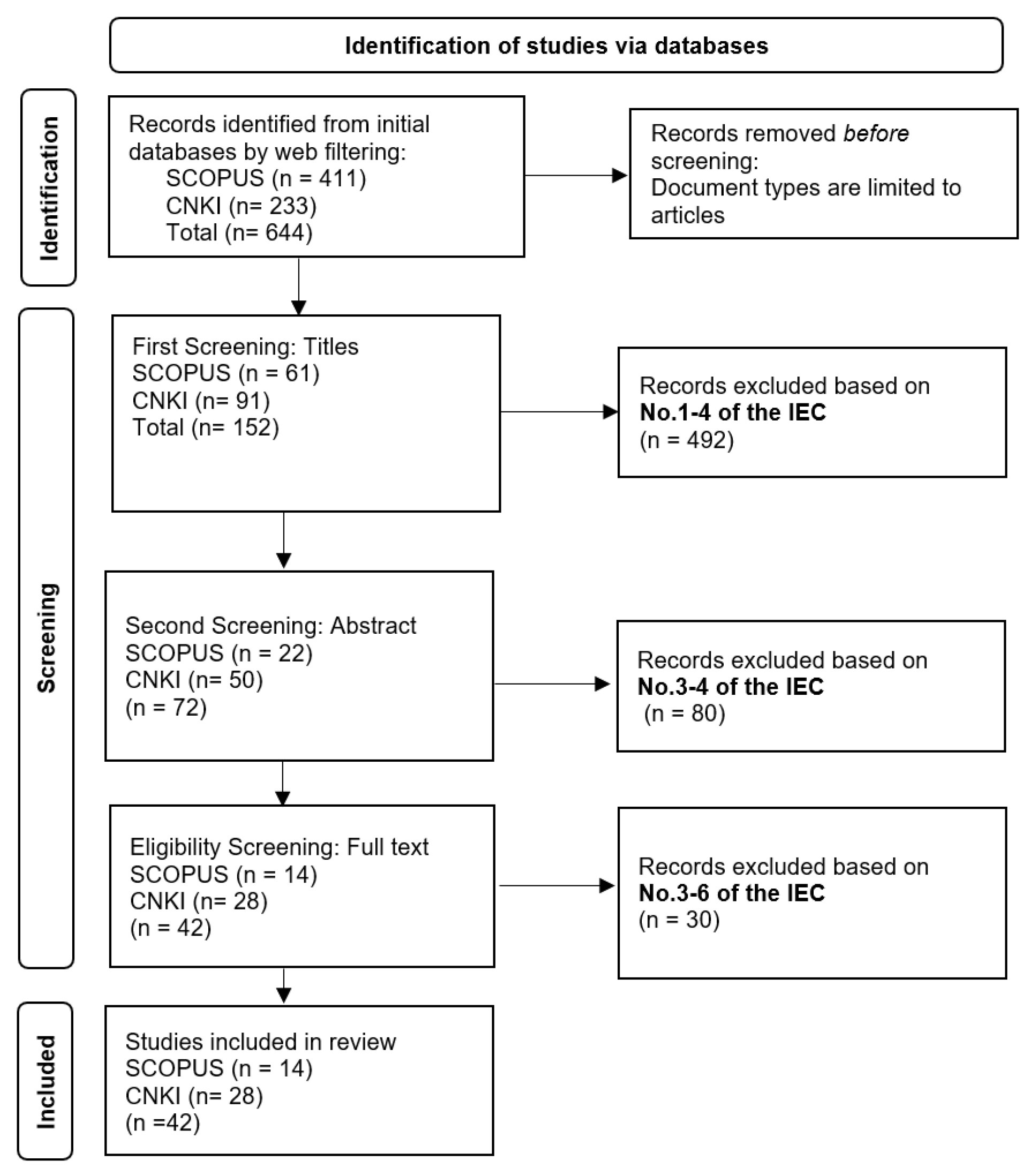

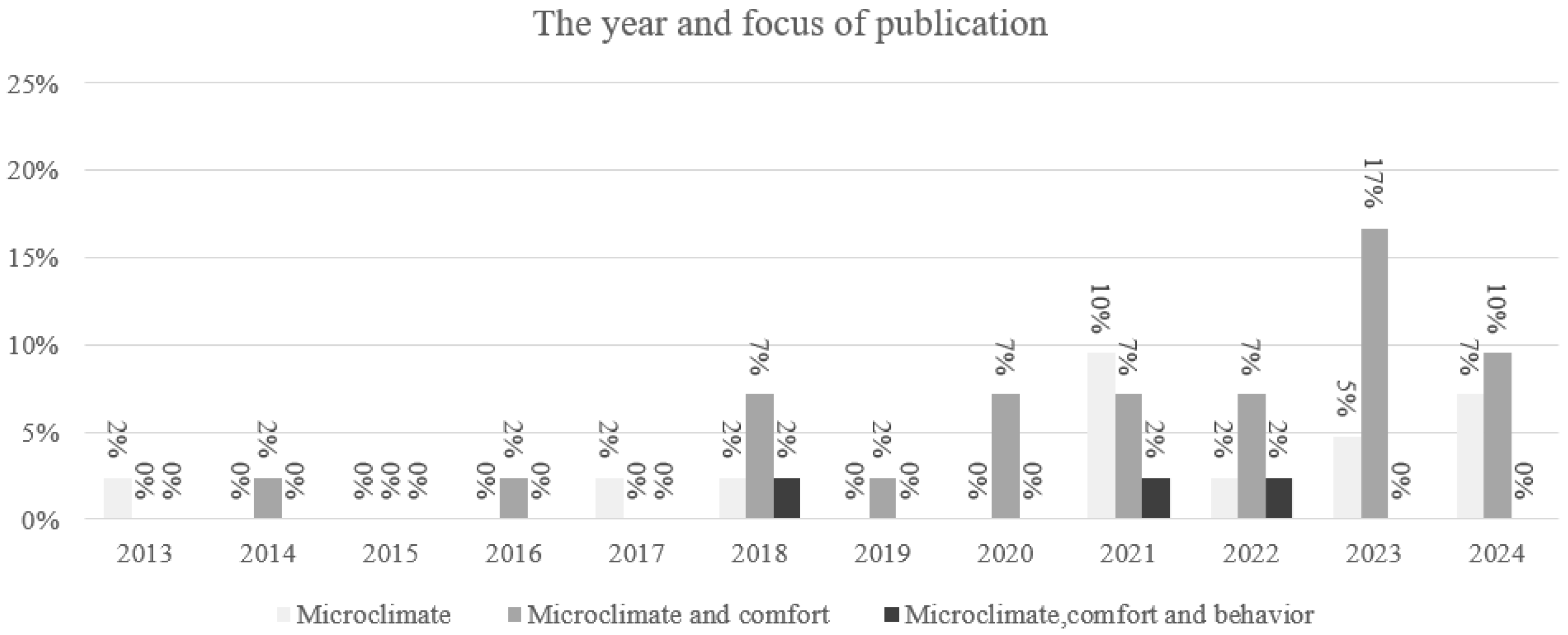
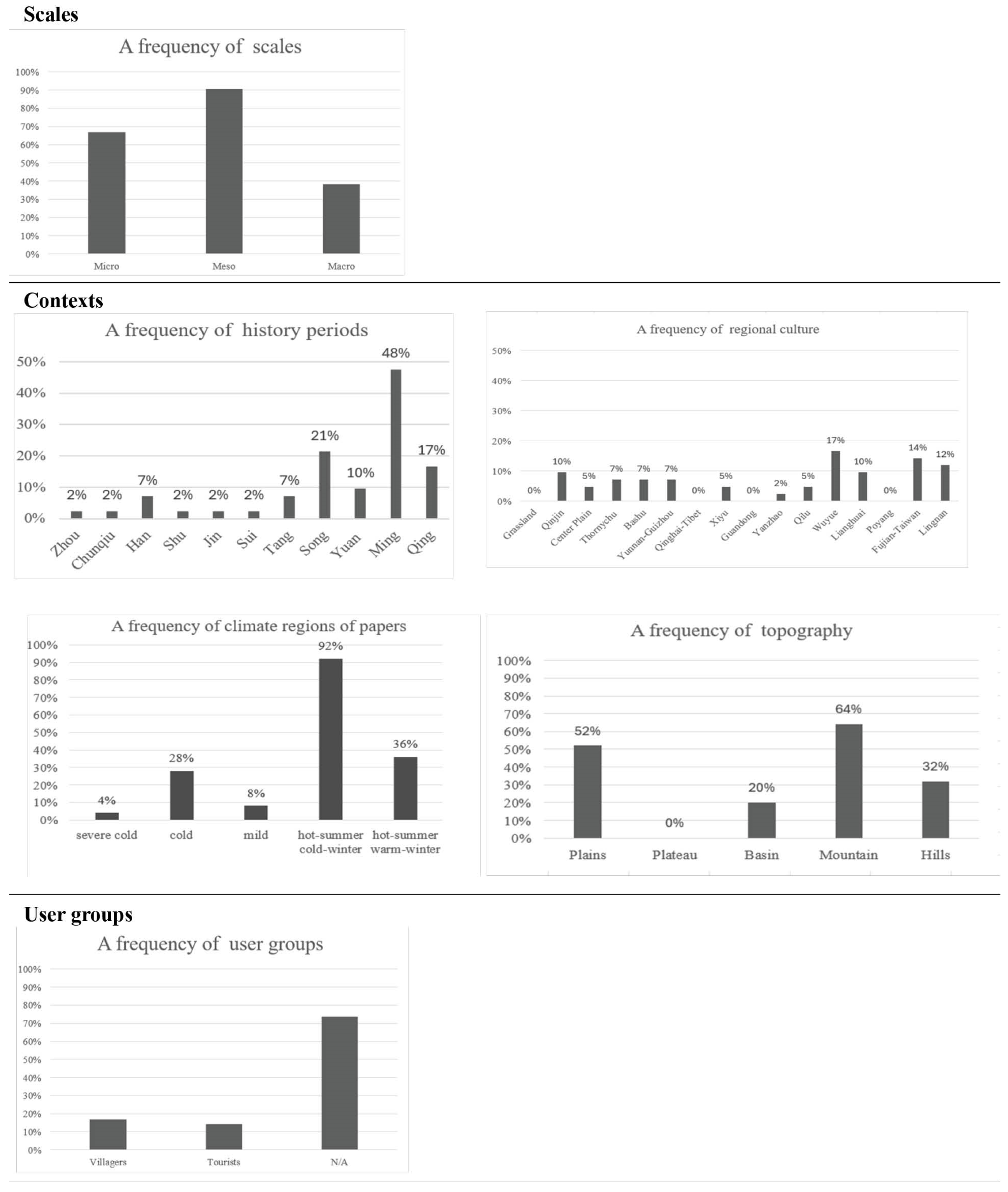
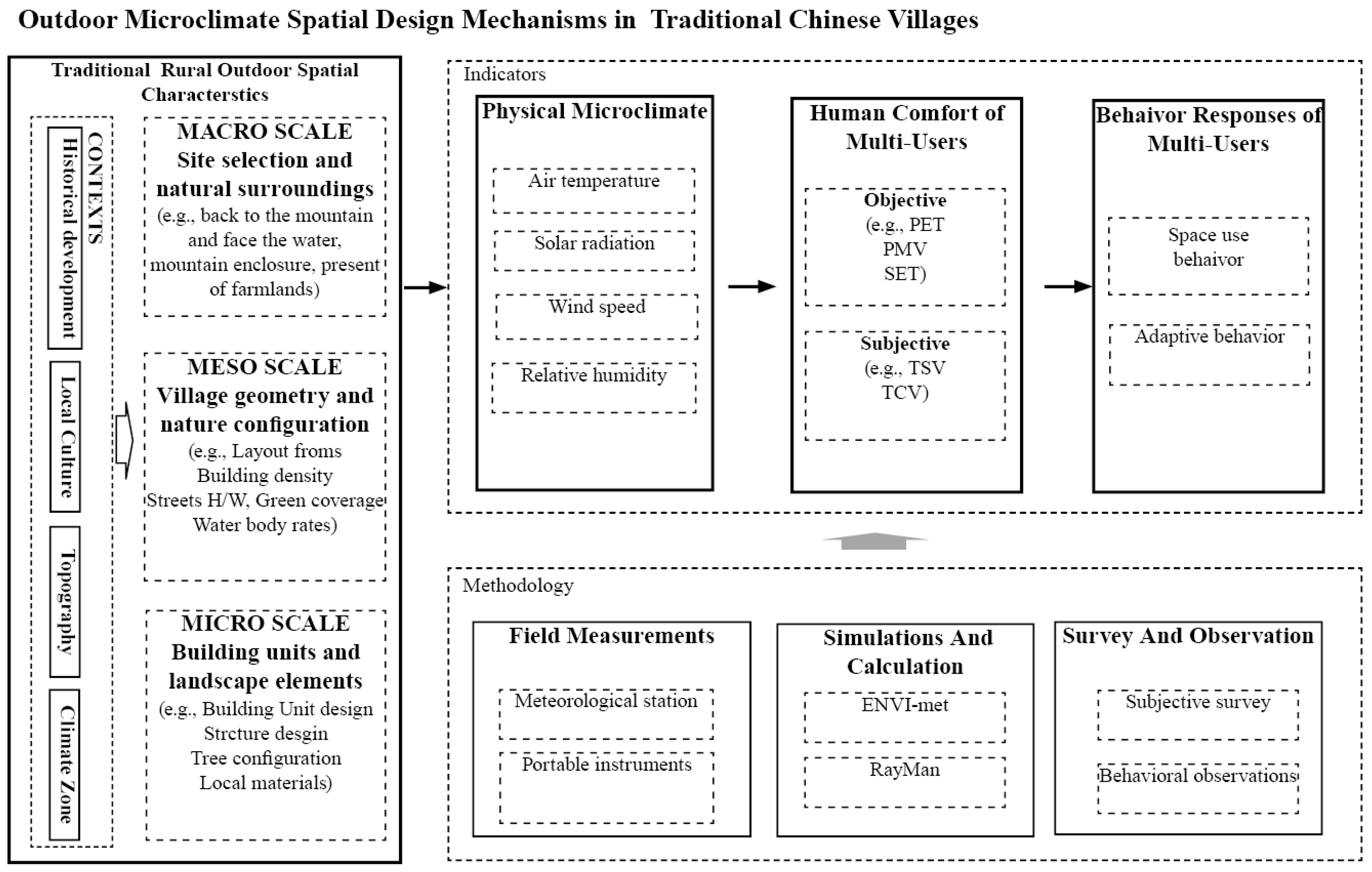

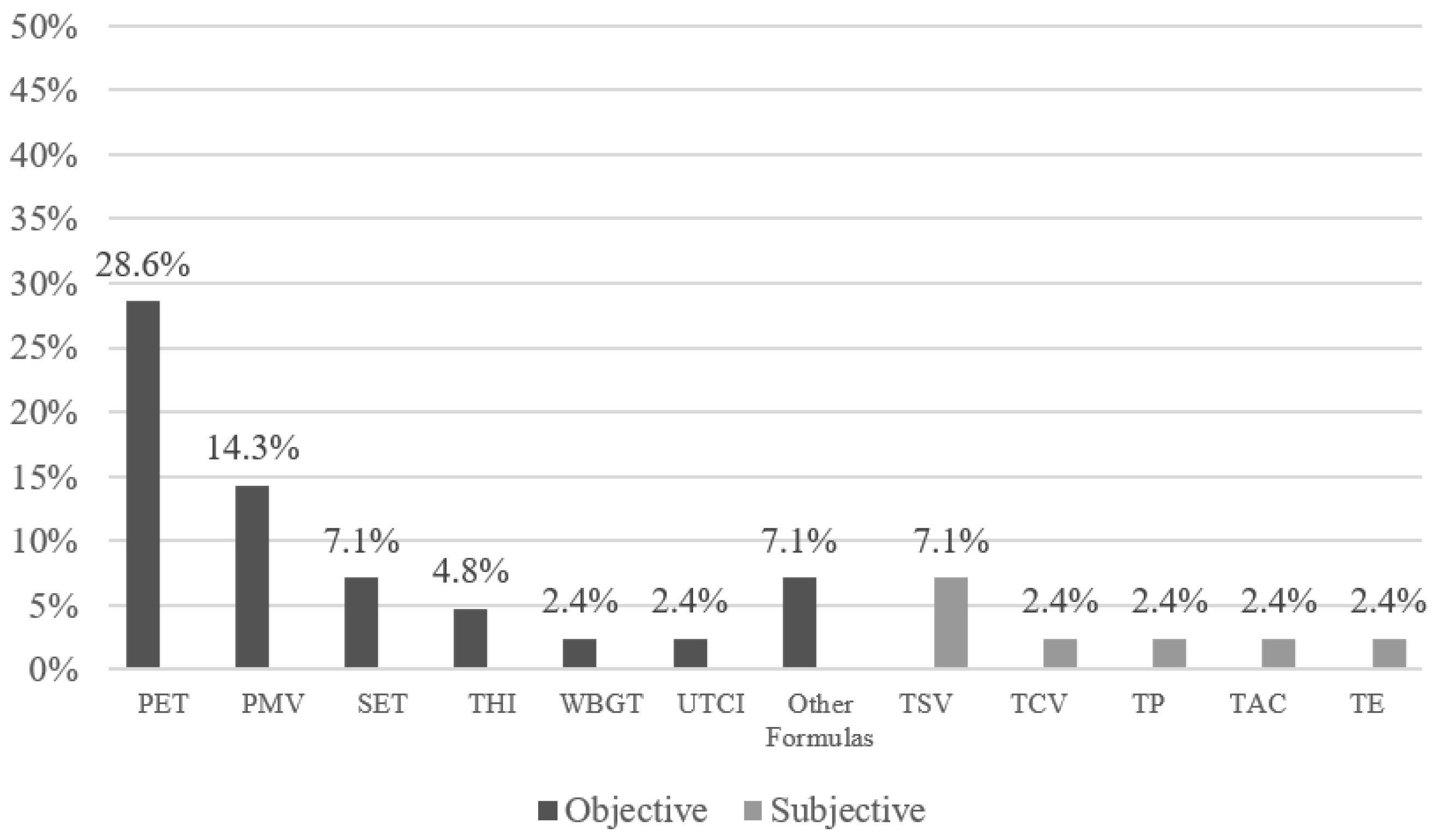
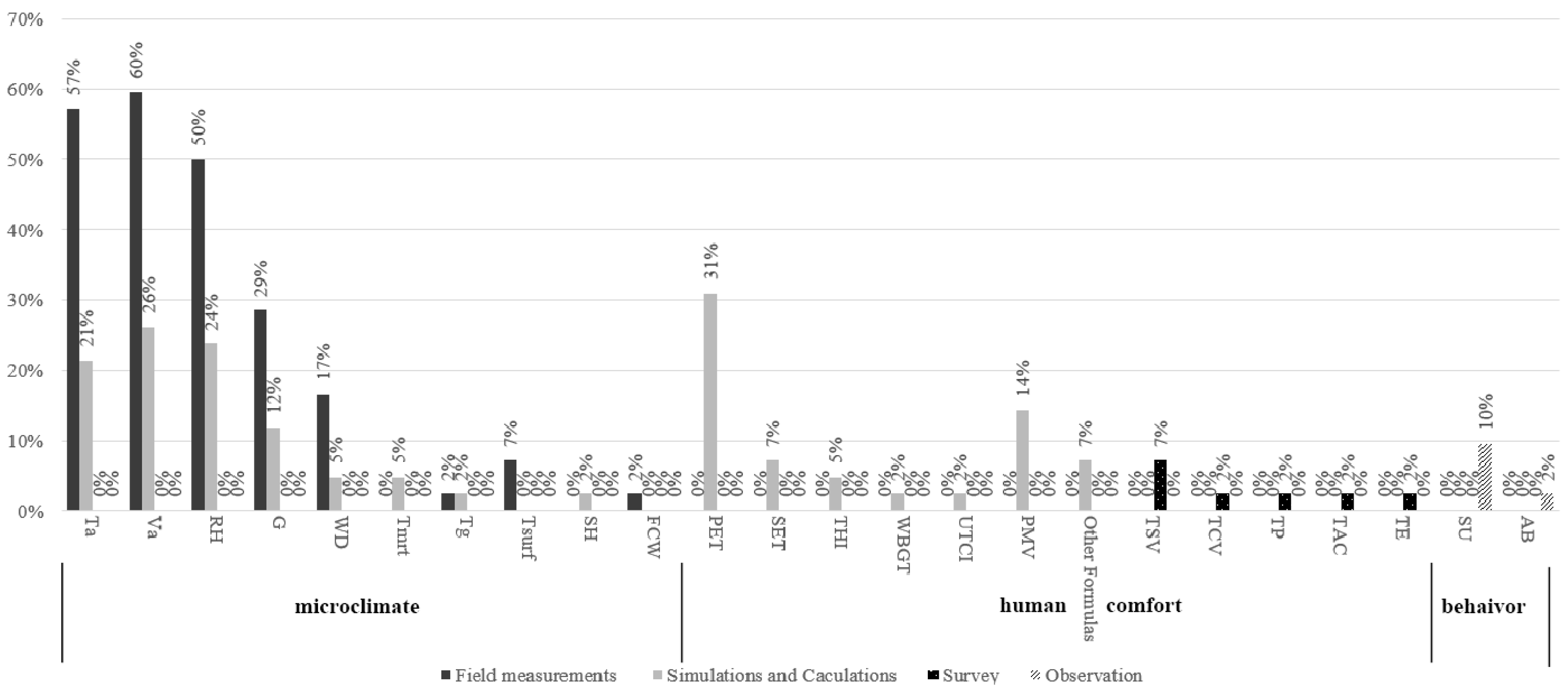
| Groups | Search Terms |
|---|---|
| Microclimate | “microclimate” OR “thermal environment” OR “thermal comfort” OR “climate adaptation” OR “microclimate comfort” |
| AND | |
| Outdoor space | “open space” OR “public space” OR “outdoor area” OR “outdoor” |
| AND | |
| Village | village OR rural OR country OR countryside |
| Inclusion Criteria | Exclusion Criteria |
|---|---|
| 1. Unique research papers | 1. Duplicate papers |
| 2. English and Chinese papers | 2. Other-language papers |
| 3. Empirical findings | 3. Other types of papers * |
| 4. Relevant papers: relevant to China, research fields *, KWL (Table 1), spatial types and research scope *, and the research questions | 4. Irrelevant papers: irrelevant to China, research fields *, KWL, spatial types and research scope *, and the research questions |
| 5. Available full-text papers | 5. Not fully available full-text papers |
| 6. Paper with high quality | 6. Paper with low quality (untrustworthy and logically inconsistent articles) |
| Ta | Air temperature (°C) | SET | Standard Effective Temperature |
| Va | Wind speed (m/s) | THI | Temperature–humidity index |
| RH | Relative humidity (%) | WBGT | Wet-bulb globe temperature |
| G | Global radiation (w/m2) | UTCI | Universal thermal climate index |
| WD | Wind direction | PMV | Predicted mean vote |
| Tmrt | Mean radiant temperature | TSV | Thermal sensation vote |
| Tg | Globe temperature (°C) | TCV | Thermal comfort tote |
| Tsurf | Surface temperature | TP | Thermal preference |
| SH | Sunlight hours | TAC | Thermal acceptability |
| FCW | Frequency of calm winds | TE | Thermal expectation |
| PET | Physiological equivalent temperature | SU | Space usage behavior |
| AB | Adaptation behavior |
| Classifications | Indicators | Ref. |
|---|---|---|
| Space usage | Number of users | [25] |
| Time slot | [37,49] | |
| Frequency | [26,50] | |
| Duration | [49] | |
| Behavior types | [49] | |
| Adaptive behaviors | Adjusting clothing | [26,37] |
| Using sun-shading umbrellas | [37] | |
| Resting underneath shading objects | [37] | |
| Drinking hot water and tea | [26] |
Disclaimer/Publisher’s Note: The statements, opinions and data contained in all publications are solely those of the individual author(s) and contributor(s) and not of MDPI and/or the editor(s). MDPI and/or the editor(s) disclaim responsibility for any injury to people or property resulting from any ideas, methods, instructions or products referred to in the content. |
© 2025 by the authors. Licensee MDPI, Basel, Switzerland. This article is an open access article distributed under the terms and conditions of the Creative Commons Attribution (CC BY) license (https://creativecommons.org/licenses/by/4.0/).
Share and Cite
Wan, Z.; Liu, H.; Yu, Y.; Wu, Y.; Melchior, M.; Martens, P.; Krafft, T.; Shaw, D. How Does Outdoor Spatial Design Shape the Microclimate, Comfort, and Behavior in Traditional Chinese Villages? A Systematic Review Across Scales, Contexts, and Users. Sustainability 2025, 17, 6960. https://doi.org/10.3390/su17156960
Wan Z, Liu H, Yu Y, Wu Y, Melchior M, Martens P, Krafft T, Shaw D. How Does Outdoor Spatial Design Shape the Microclimate, Comfort, and Behavior in Traditional Chinese Villages? A Systematic Review Across Scales, Contexts, and Users. Sustainability. 2025; 17(15):6960. https://doi.org/10.3390/su17156960
Chicago/Turabian StyleWan, Zixi, Huihui Liu, Yan Yu, Yan Wu, Mark Melchior, Pim Martens, Thomas Krafft, and David Shaw. 2025. "How Does Outdoor Spatial Design Shape the Microclimate, Comfort, and Behavior in Traditional Chinese Villages? A Systematic Review Across Scales, Contexts, and Users" Sustainability 17, no. 15: 6960. https://doi.org/10.3390/su17156960
APA StyleWan, Z., Liu, H., Yu, Y., Wu, Y., Melchior, M., Martens, P., Krafft, T., & Shaw, D. (2025). How Does Outdoor Spatial Design Shape the Microclimate, Comfort, and Behavior in Traditional Chinese Villages? A Systematic Review Across Scales, Contexts, and Users. Sustainability, 17(15), 6960. https://doi.org/10.3390/su17156960







